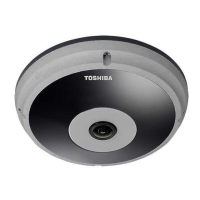
Do you have a question about the Toshiba IK-WF51R and is the answer not in the manual?
| Resolution | 1280 x 720 |
|---|---|
| Effective Pixels | 1.0 Megapixel |
| Frame Rate | 30 fps |
| Lens | 3.6 mm |
| Minimum Illumination | 0.5 Lux |
| Video Compression | H.264 |
| Wireless | No |
| Operating Temperature | -10°C to 50°C |
| Signal-to-Noise Ratio | 50 dB |
| Network Interface | RJ45 |
| Protocols | TCP/IP, HTTP, DHCP, DNS, DDNS, SMTP, NTP |
| IR Distance | Up to 10m |
| Image Sensor | 1/3 inch CMOS |
| Power Supply | DC 12V |
Guidance on verifying package contents and connecting the Ethernet cable.
Defines 'User' and 'Administrator' roles and refers to QSG for network setup.
Details steps to access the camera via web browser, including launching and entering IP address.
Configure basic settings like host name and system time for the network camera.
Instructions for downloading and upgrading the camera's firmware from the TOSHIBA website.
Enables password protection by setting a root password for administrator access.
Manages user privileges (Operator, Viewer) for digital output and PTZ control.
Create, modify, or delete user accounts with different access rights (Admin, Operator, Viewer).
Guides through creating and installing certificates for secure HTTPS communication.
Procedure to create a certificate request and install it from a certificate authority.
Configure maximum concurrent streaming clients and manage connection status.
Define single IP, network address, or IP range rules for access control lists.
Enables access list filtering to allow or deny access based on IP addresses.
Enables port-based network access control using IEEE 802.1x and EAP methods.
Configure network type as LAN or PPPoE, with options for automatic or fixed IP addressing.
Set static IP, subnet mask, default router, and primary DNS provided by ISP.
Configure HTTP authentication (basic/digest) and ports for streaming media.
Configure RTSP authentication and access names for multiple video streams.
Configure video title, mount type, timestamp position, font size, color, and power line frequency.
Block sensitive zones by setting up privacy mask windows to address privacy concerns.
Select between Hemispheric View or 1080P Full HD mode for video output.
Configure audio settings including mute, microphone source, input gain, and audio type (AAC, G.711, G.726).
Configure events to trigger actions like sending snapshots or videos via FTP or email.
Set event schedule, priority, and choose trigger sources like motion detection or digital input.
Define actions for triggers: digital output, backup media on network disconnection.
Configure email server settings to send media files via email upon trigger activation.
Configure FTP server settings to send media files, including passive mode and folder name.
Configure HTTP server settings to send media files, including URL and user credentials.
Configure snapshot settings, including source, pre/post-event images, and file name prefix.
Configure video clip settings: source, pre-event recording, max duration, file size, and prefix.
Configure motion detection windows, sensitivity, and percentage for detecting movement.
Define adaptive recording, source, schedule, and capacity, enabling frame rate control on alarm triggers.
Refer to page 15 for troubleshooting operational problems via reset and restore functions.